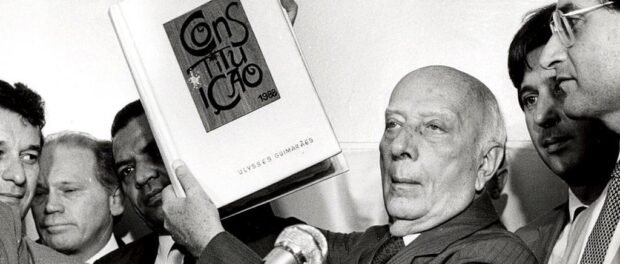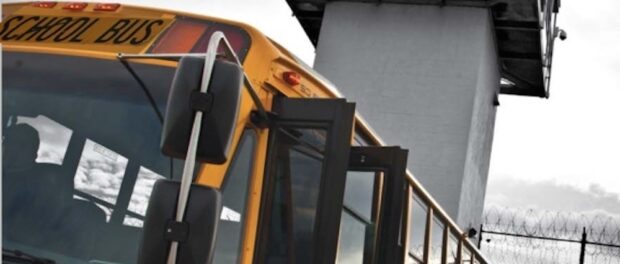
In the United States and Brazil, two countries with deep histories of racial injustice, disparities in educational opportunities between racial minorities and white populations manifest as early as preschool. The chances of incarceration significantly increase in poor black populations, greatly due to the structures and policies that begin at the start of formal schooling. This pattern has been termed the school-to-prison pipeline, and the American Civil Liberties Union (ACLU) defines the pipeline as “the policies and practices that push our nation’s schoolchildren, especially our most at-risk children, out of classrooms and into the juvenile and criminal justice systems.”
For both Brazil and the United States, the pipeline starts with inadequate resources directed to public schools in stressed neighborhoods. Due to a lack of educational opportunities combined with strict and often unfair punishment policies, many black students end up leaving school and ultimately engaging in criminal activity. In the United States, nearly 1 million black people now make up 43% of the country’s 2.3 million incarcerated population. Afro-Brazilians make up 61% of the 622,200 incarcerated in Brazil.
In recent years, jarring statistics reflecting prison rates among black communities have gained increasing attention. But not enough has been done to uproot these patterns that manifest as early as preschool. And while both countries reflect glaring similarities in terms of prison rates and educational disparities, the United States differs from Brazil in terms of structure and relevant public policy.
Historical Context: The United States
Inequality of opportunity in the United States was born in slavery and maintained thereafter. After the American Civil War, Southern states enacted a number of laws to limit civil rights and opportunities for black citizens. These policies, called Jim Crow laws, enforced racial segregation and made it impossible for the black population to vote for public office, use public goods and services, and access education. Black and white children were forbidden to study in the same public schools in order to uphold the “separate but equal” ideology put forth by Southern Democrats at the time. Racial segregation in schools was maintained across the country until the 1954 Brown v. Board of Education Supreme Court decision that determined segregation unequal and ordered public schools to be fully desegregated as soon as possible. However, it was not until the signing of the 1964 Civil Rights Act that black citizens gained equal protection under the law and freedom to access the same facilities as white citizens without discrimination.
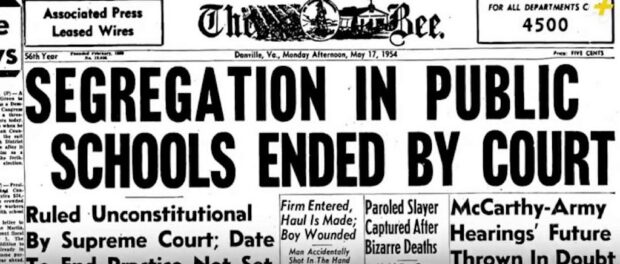
Although 1964 marked a new era ending legal racial discrimination, black residents continued suffering from covertly (and sometimes overtly) racist policies, exacerbating social inequalities. Throughout the 20th century, banks consistently denied loans to homeowners and would-be homeowners in traditionally black neighborhoods through a practice called “redlining.” Federal housing agencies determined how fit certain neighborhoods were to receive investment from banks and insurance companies largely based on how close they were to “negro” neighborhoods; those deemed unfit for investment were shaded in red. Redlining excluded black communities from opportunities for financial growth and mobility, hurting local businesses, public spaces, and neighborhood schools.
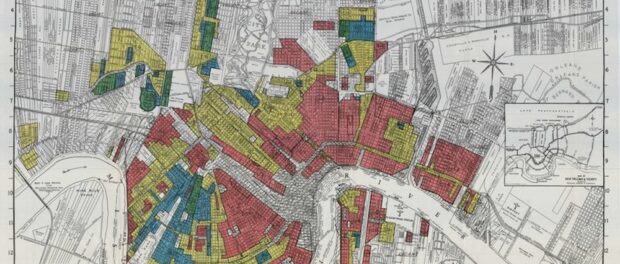
Current Situation: The United States
In recent decades, social and racial exclusion have manifested in school districting as well. In the United States, students normally attend the public schools closest to where they live, and due to economic disparities and previously mentioned historical housing segregation policies, classrooms tend to reflect a lack of racial and economic diversity. Making matters worse, public school districts with higher percentages of black and racial minority students almost universally receive less funding than schools with higher percentages of white students, independent of the district’s economic background. In the United States, a large part of school funding comes from property taxes, and racial minority families tend to live in poorer neighborhoods. However, “if you color code the districts based on their racial composition you see this very stark breakdown. At any given poverty level, districts that have a higher proportion of white students get substantially higher funding than districts that have more minority students,” said data scientist David Mosenkis. Unequal funding for certain populations results in a racial achievement gap that puts black and minority students at a huge disadvantage. With less funding comes lower quality teachers and fewer resources to provide students with the tools they need to succeed.
Already at a double-disadvantage (being discriminated against and receiving fewer educational resources), on top of this there exists a common trend of tension between law enforcement and black communities, in particular. These tensions start to build in schools and classrooms, with school suspensions as early as preschool. According to data from 2014, “black students make up 18% of children enrolled in preschools, and 48% of these kids experience more than one out-of-school suspension. White students make up 43% of enrollment but account for just 26% of students with more than one suspension.” In underfunded public schools across the country, police officers unnecessarily intervene in minor situations, creating a dynamic of resentment towards law enforcement and unfair treatment of students. According to the ACLU, “many under-resourced schools place increased reliance on police rather than teachers and administrators to maintain discipline. Growing numbers of districts employ school resource officers to patrol school hallways, often with little or no training in working with youth. As a result, children are far more likely to be subject to school-based arrests—the majority of which are for non-violent offenses.”
The inappropriate use of police officers in schools exacerbates tensions between populations of color and law enforcement in general. According to research done by the Advancement Project, “in many places where police are overused or misused in schools, young people also begin to resent and distrust them. It is commonplace for young people to lose faith in the goodwill of police when they believe they are being treated unfairly in their schools. And, unfortunately, these feelings continue beyond the schoolhouse doors.”
One of the major side effects of the racial achievement gap is the increased likeliness of dropping out of high school altogether. Those who drop out of school are much more likely to turn to illegal activity as a form of income. According to a study done by the U.S. Department of Education in 2013, 86.6% of white students graduate high school, in comparison with only 71% of black students.
The United States has a history of disproportionate imprisonment rates for minority racial groups. Based on data from the National Association for the Advancement of Colored People (NAACP), “African Americans and Hispanics comprised 58% of all prisoners in 2008, even though African Americans and Hispanics make up approximately one quarter of the US population.” This does not necessarily mean that minorities are committing more crimes, either. For example, “Five times as many whites are using drugs as blacks, yet blacks are sent to prison for drug offenses at ten times the rate of whites.” In order to combat the racially charged preschool-to-prison pipeline in the United States, we must implement policies to fairly distribute resources to schools and examine how we stimulate and reprimand students.
Historical Context: Brazil
Like the United States, inequality of opportunity in Brazil dates back to times of slavery. Brazil imported the most slaves of any country in world history. During the Constitutional Monarchy, the Portuguese crown feared a lettered elite and therefore never invested in education. This thinking was closely connected with the ideology of racial purity, which measured a person’s status by the level of African or indigenous blood. Those deemed “less pure” and thus inferior were excluded from education and job opportunities.
In 1889, one year after the abolition of slavery, the Monarchy was replaced by a Republican government. The Republican Constitution did not establish education as a basic right for all citizens. Afro-Brazilians, who made up the majority of the population, were excluded from school. However, due to a desire to “Europeanize” Brazil, educational leaders did not prevent Afro-Brazilians from going to school, as they saw education as the solution to the “cultural degenerate.” Although the federal government subsidized states for primary and secondary schooling, the funds reached less than half of the population. Due to pressure from the political group “Pioneers of the New School,” the 1934 Constitution included the universal right to education.
Getúlio Vargas’ military dictatorship interrupted all education laws in 1937, leading to another round of reforms. Educational reform was established on a federal level, and a national curriculum was developed for all age groups. With the end of the dictatorship after World War II, the 1946 Constitution changed education laws to four years of free and compulsory primary education for all children aged 7 and older. Those in extreme poverty, however, were excluded from this obligation.
Popular demand for education towards the end of the twenty-year military dictatorship (1964-1985) led to an increase in the opportunity to enroll. But the quality of education declined due to lack of public investment.
It was not until ratification of the 1988 Constitution that public school was considered a legal right. With the new democratic system, 18% of the annual federal budget was dedicated towards education spending.
Current Situation: Brazil
In the last few decades, several factors have exacerbated education inequality in Brazil. One fourth of the schools in Brazil are private and serve students whose parents can afford to pay the expensive tuitions, whereas public schools normally attend students from low-income families. The funding for these schools is tied to state and city budgets, so schools in wealthier cities are better funded than those in poorer states and areas outside of big cities.
Poor public education at both primary and secondary levels is visible in the number of functionally illiterate Brazilian undergraduates. Based on a study done by the Paulo Montenegro Institute (IPM) in 2012, 65% of students with a high school diploma are unable to comprehend basic texts. In an attempt to combat these numbers, the government launched the National Educational Plan in 2014, in which it included measures to increase the years of mandatory education (now from 4 to 17 years of age), raise enrollment rates, and improve teacher qualification.
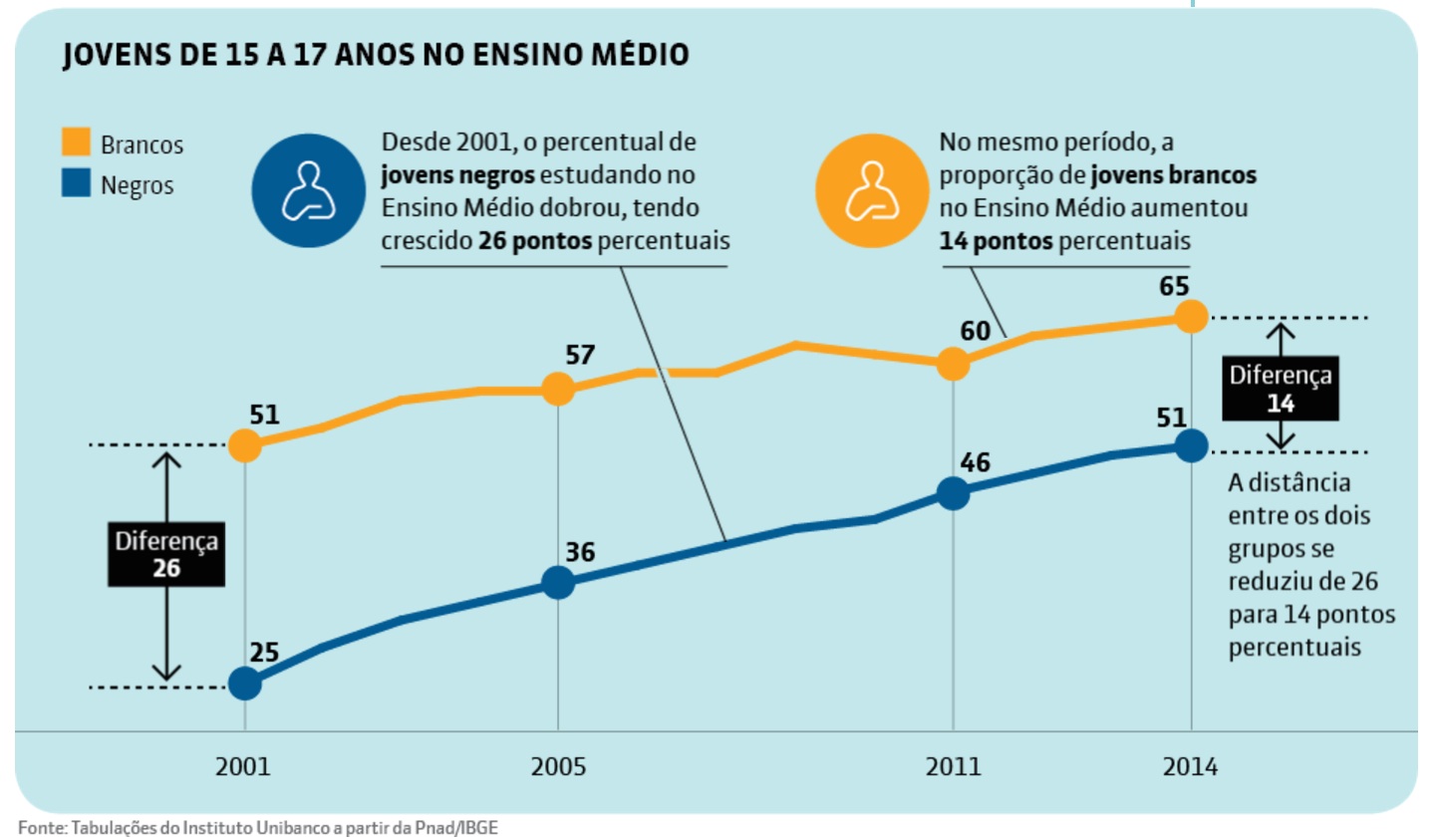
A 2015 Unibanco Institute report shows that more than half of black or brown students are now enrolled in secondary schools, but that racial enrollment gaps are still significantly large. The OECD’s Program for International Student Assessment (PISA) Report on Brazil in 2015 concluded that “spending on education has increased since 2012, but Brazil still faces the challenge of translating the additional expenditure into better learning outcomes.” 71% of 15-year-olds are now in school or enrolled in grade 7 or above, 15% higher than in 2003. However, Brazil has a large percentage of disadvantaged students. Students in Brazil score below the OECD average and comparable to those of Indonesia and Peru. And “in Brazil, principals of public schools are more concerned about the material resources in their school than principals of private schools.” Brazil’s mean performance has remained unchanged since 2006.
Importantly, mandatory enrollment and conditional transfer programs have incentivized schooling (e.g. Bolsa Família) in Brazil. According to a study conducted by the World Bank in 2007, which points out that “there is an intimate relationship between education, socioeconomic conditions, and crime,” in São Paulo, 20-25% of crimes among those whose ages are known, are committed by youth below the age of 18. This study found that Brazil’s Bolsa Família program, by guaranteeing both a basic income and school attendance in low-income families, effectively reduces crime rates by 6-18%.
However, structural improvements are still lacking and this predominantly affects low-income families. Due to poor public schools, middle and upper class families place their children in private schools, exacerbating achievement gaps. The differences among students from public and private schools become even more glaring when competing for a spot at public universities, especially now as more children of lower-income families finish high school. In Brazil, the most competitive universities are public and also free. However, the entry exam (vestibular) for these universities is designed for those with extensive training. Families who can invest in private schools and pay for an expensive preparatory course have the best possibility to enter public universities, often excluding students from lower socio-economic backgrounds.
As a first step to decreasing education inequalities in universities, the federal government passed a law in 2012 that allocated 50% of the vacancies of federal universities (Brazil’s top universities) for students from public schools. A certain number of these vacancies were designated for students with a family income equal to or less than 1.5 times the minimum wage, and another portion was guaranteed for black, mixed race, and indigenous students. While incredibly effective in providing access to top students of all racial backgrounds who reach university, quotas do not address the government’s greater responsibility of improving the quality of K-12 public education.
Brazil’s public schools are also marked by high dropout and grade repetition rates, often due to student disengagement. Among 15 to 17-year-olds not attending public school, 19% have a high school degree. Among the white population, this number is 28%, while among the black population, this number is just 15%.
There are numerous factors that lead to school abandonment. In many cases, students lose interest due to poor quality of teaching and a rigid curriculum that allows for little flexibility. Additionally, a 2009 survey on prejudice and discrimination in school environments concluded that disengagement and dropout rates are linked to discrimination. The study identified race as one of the main sources of bullying, and found that higher dropout rates occurred at schools with a higher level of prejudice.
In 2015, Brazil’s Congress approved a constitutional amendment (PEC 171/93) that reduces the age of criminal responsibility for violent crimes from 18 to 16. Opponents argue that lowering the age and increasing the length of prison sentences only worsens racial disparities in the Brazilian justice system. Due to a lack of opportunities for resocialization, convicts released from prison are 70-80% likely to become repeat offenders.
Due to a colonial legacy of racial inequalities and inadequate opportunities for education, certain populations in Brazil have a higher likelihood of leaving school and ending up in the criminal justice system. While reform remains necessary, the government would have to nearly double federal and state education spending in 2017 in order to meet targets set by the government in the National Education Plan. However, the federal government has recently passed the Austerity Amendment PEC 55, which created a 20-year public spending ceiling. Until Brazil drastically changes its approach to education policy, prison statistics will continue to reflect racially charged opportunity gaps.
Conclusion
While the United States’ and Brazil’s policies have been influenced by unique historical factors, both countries share systemic racism rooted in times of slavery, high incarceration rates, and academic access and achievement gaps. Both countries are characterized by a school-to-prison pipeline. The “War on Crime,” a U.S. initiative started by President Johnson in 1965 to invest in combating crime on a federal level, picked up steam not only domestically but around the world. The movement resulted in exponential growth of incarceration rates, specifically for small drug crimes. Today, the United States and Brazil are home to some of the world’s largest prison populations. In addition to objectively unfair justice systems in both countries, lack of educational opportunities exacerbate patterns of crime and imprisonment. Unfortunately, these disparities manifest themselves as early as preschool.

